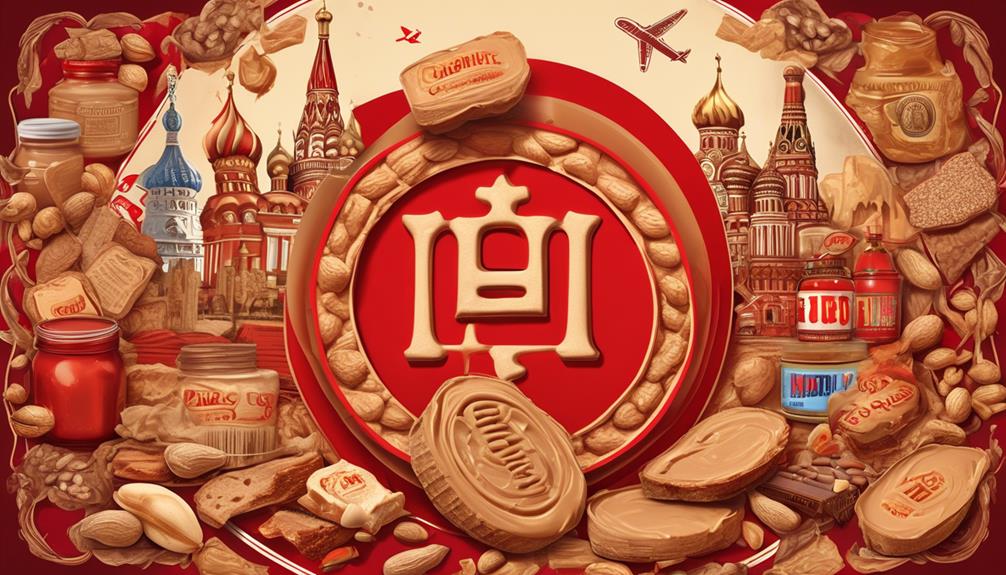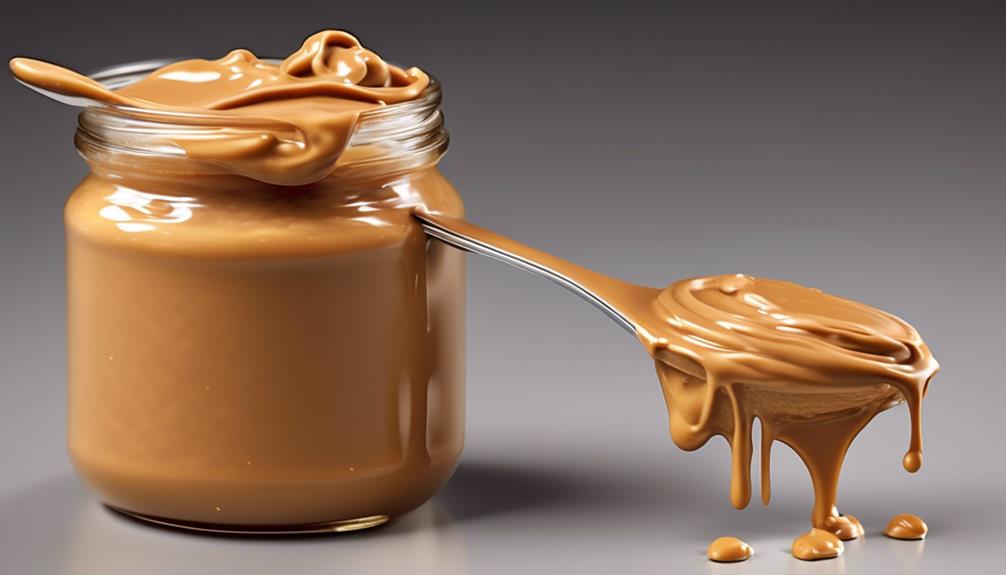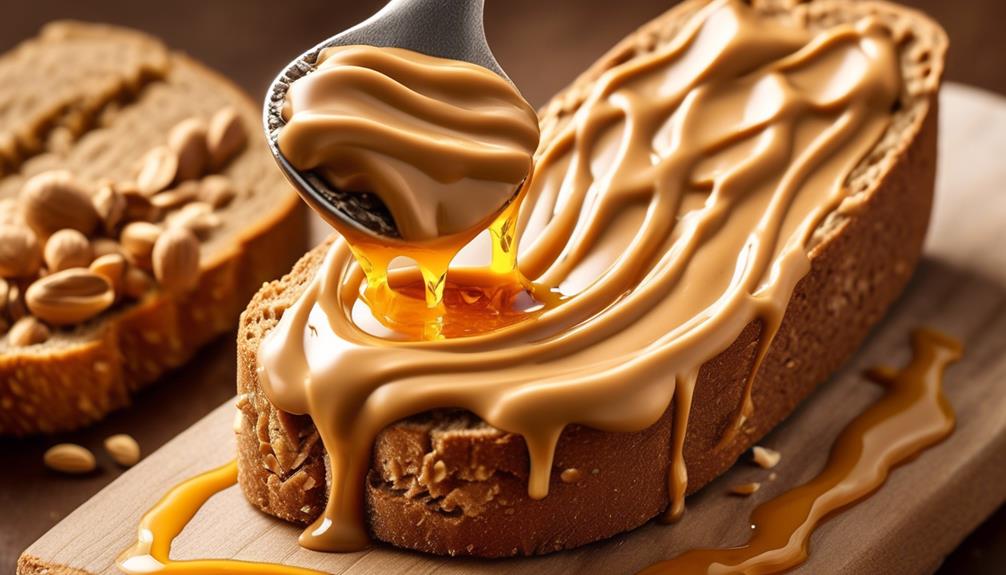So, have you ever wondered why peanut butter is not widely available in Russia? It's a curious thing, isn't it?
Despite being a staple in many American households, the creamy or crunchy spread is a rarity in Russian grocery stores. There seems to be a complex interplay of historical, political, and economic factors at play here, shaping the availability and accessibility of this beloved American product in the Russian market.
Let's uncover the layers of this intriguing phenomenon and explore the underlying reasons behind the scarcity of peanut butter in Russia.
Key Takeaways
- Peanut butter is not officially banned in Russia, but its limited availability is influenced by political implications and trade constraints.
- The scarcity of peanut butter in Russia reflects broader socio-economic and cultural shifts in the country.
- Health concerns and regulations on imported peanut butter likely exist due to allergen concerns and food safety standards.
- Economic sanctions and trade restrictions historically have had an impact on the availability of goods like peanut butter in Russia.
History of Peanut Butter in Russia
Peanut butter has historically been a rarity in Russia, with limited accessibility during the Soviet era and still being relatively scarce in the country today. The history of peanut butter in Russia is intertwined with the country's complex socio-political landscape.
During the Soviet era, the scarcity of peanut butter was largely due to the closed nature of the Soviet economy, which limited the import of Western goods. As a result, peanut butter was considered a luxury item, available only to the privileged few.
The limited availability of peanut butter in Russia continued even after the collapse of the Soviet Union. While the market gradually opened up to foreign products, peanut butter remained a niche product, mainly found in high-end markets, health food stores, and major supermarket chains. This scarcity has led to a fascination with peanut butter among Russians, with some even considering it a symbol of Western indulgence.
The history of peanut butter in Russia reflects the broader socio-economic and cultural shifts that have taken place in the country. Despite being relatively scarce, the allure of peanut butter has persisted, making it a sought-after commodity in the Russian market.
Health Concerns and Regulations

Despite the scarcity of peanut butter in Russia, the regulations on importing and selling this product may be influenced by health concerns, allergen considerations, and food safety standards.
Health authorities in Russia likely have strict regulations on the ingredients and production processes of imported peanut butter, possibly due to allergen concerns related to peanuts.
Additionally, regulations on importing and selling peanut butter in Russia may be influenced by food safety and quality control standards.
The limited availability of peanut butter in Russia could be linked to health concerns or regulations regarding the presence of additives or preservatives in the product.
These regulations, while potentially contributing to the scarcity of peanut butter, align with efforts to ensure the safety and quality of food products available to consumers in Russia.
It's crucial for authorities to prioritize the well-being of the population, and these regulations may be a reflection of their commitment to maintaining high standards for food safety and allergen control.
Political Implications and Trade Restrictions

The trade impact on relations between America and Russia, as well as the economic sanctions effect, are key points to consider when examining the peanut butter ban.
Political tensions and bans surrounding the import and export of goods like peanut butter play a significant role in shaping international relations.
Understanding the historical context and motivations behind trade restrictions can provide insight into the complexities of global politics.
Trade Impact on Relations
During the Cold War, trade restrictions between the United States and Russia posed significant challenges in the transportation and availability of peanut butter in Russia, reflecting the political implications and trade restrictions of that era.
The limited availability of peanut butter in Russia today continues to be influenced by trade relations and embargoes.
The representation of American products like peanut butter in Russian markets reflects the impact of trade restrictions on cultural perceptions and consumer choices.
The peanut butter smuggling subplot in the show Stranger Things sheds light on the historical tensions between the two countries, showing how trade restrictions and embargoes have affected the availability and perception of American goods in Russia.
This ongoing trade impact on relations between the United States and Russia underscores the enduring influence of historical trade restrictions on cultural and economic exchanges.
Economic Sanctions Effect
Amid the enduring impact of historical trade restrictions on cultural and economic exchanges, the role of economic sanctions in affecting the availability of goods like peanut butter in Russia becomes increasingly significant. The limited accessibility of peanut butter in Russia showcases the impact of trade restrictions and the implications of economic sanctions on the availability of goods.
Political tensions and trade embargoes, such as those during the Cold War era, have historically led to economic sanctions, impacting the import and export of specific products. The portrayal of peanut butter smuggling in the show accurately reflects the real history of trade embargoes and restrictions between the United States and Russia during the 1980s.
The broader implications of economic sanctions, trade restrictions, and political tensions on everyday life and cultural exchange are highlighted through the peanut butter storyline, shedding light on the complexities of international relations.
Political Tensions and Bans
Political tensions and trade restrictions have historically played a significant role in shaping the availability of goods like peanut butter in Russia, reflecting the complex interplay of international relations and economic sanctions.
While peanut butter isn't officially banned in Russia, its limited availability is intertwined with political implications and trade constraints.
During the Cold War era, trade restrictions and political tensions between the United States and Russia greatly impacted the access to American products, including peanut butter.
The portrayal of peanut butter as a coveted item in Russia in popular media underscores the cultural differences and perceptions of Western goods. These depictions provide insight into the historical context of trade relations and the emotional resonance of scarcity.
The scarcity of peanut butter in Russia continues to spark curiosity and prompt discussions about the enduring impact of political tensions on the availability of goods.
Impact on Russian Consumers and Businesses

The limited availability of peanut butter in Russia and the fascination with American products reflect a strong demand for this particular food item.
The ban on peanut butter could have significant impacts on the health choices and dietary habits of Russian consumers.
Additionally, businesses that rely on the import or sale of peanut butter may face economic consequences due to the sudden restriction.
Impact on Health
Limited accessibility of peanut butter in Russia may impact the nutritional options available to consumers and pose challenges for businesses specializing in its import and sale. As a result, the impact on health due to the peanut butter ban in Russia is significant.
The current situation affects both consumers and businesses in various ways:
- Nutritional options: Consumers may face limited choices for obtaining essential nutrients found in peanut butter, impacting their overall diet.
- Accessibility: Limited availability in high-end markets and health food stores may restrict access, affecting those reliant on these sources for purchasing peanut butter.
- Business challenges: Importing and selling businesses may encounter hurdles, such as trade restrictions, affecting their operations and profitability.
- Consumer demand: The portrayal of peanut butter in media may influence consumer perceptions and drive increased interest and consumption, despite the ban.
Economic Consequences
We are witnessing the potential rise in prices and reduced options for consumers in Russia due to the limited availability of peanut butter, presenting challenges for businesses involved in its import and distribution.
The scarcity of peanut butter may lead to higher prices, making it less accessible to the average consumer. Additionally, the limited availability of this popular food item may prompt consumers to seek alternative options, impacting the overall demand for peanut butter.
Businesses that import peanut butter are facing hurdles due to trade restrictions and transportation difficulties, potentially affecting their bottom line. The portrayal of peanut butter as a smuggled item in the show highlights the impact of trade embargoes on both American and Russian businesses.
As a result, high-end markets, health food stores, and major supermarket chains in Russia may benefit from the exclusivity of selling peanut butter, but overall, the missing foods in Russia may leave consumers and businesses alike feeling the strain of limited choices and increased costs.
Alternatives and Potential Solutions

Considering the recent ban on peanut butter in Russia, it's worth exploring a variety of alternative spreads and potential solutions to address the absence of this popular option.
Here are some potential alternatives and solutions to the peanut butter ban in Russia:
- Consider making homemade nut butters using alternative nuts like almonds, cashews, or sunflower seeds. This allows for customization and control over ingredients.
- Explore other spreads such as almond butter, cashew butter, or sunflower seed butter as substitutes for peanut butter. These options provide similar creamy textures and rich flavors.
- Experiment with tahini, a paste made from sesame seeds, as a flavorful and nutritious alternative to peanut butter. Tahini offers a unique taste and can be used in various recipes.
- Try incorporating other protein-rich spreads like hummus, avocado spread, or Greek yogurt with honey as a replacement for peanut butter. These alternatives provide a balance of nutrients and delicious flavors.
Outlook for the Future of Peanut Butter in Russia

The recent ban on peanut butter in Russia has prompted a reevaluation of the accessibility and perception of alternative spreads, signaling a potential shift in the future demand for peanut butter in the country.
The availability of peanut butter in Russia has been limited, primarily found in high-end markets, health food stores, and major supermarket chains, indicating a niche market.
However, the emotional impact of the portrayal of peanut butter in the show has sparked curiosity and discussion among fans, potentially influencing the perception and popularity of peanut butter in Russia.
The absence of Jif peanut butter in Russia suggests that the market for this product is virtually nonexistent, but there are indications of improved accessibility to alternative brands.
The representation of peanut butter smuggling in the show reflects historical tensions between America and Russia, suggesting potential challenges in the import and distribution of peanut butter in Russia.
Additionally, the portrayal of Russian perception of Americans through peanut butter showcases cultural differences, which could influence the demand for peanut butter in Russia.
These factors collectively indicate a complex and evolving outlook for the future of peanut butter in Russia.
Frequently Asked Questions
Why Is Peanut Butter Not Allowed in Russia?
Peanut butter isn't banned in Russia, but its availability is limited due to historical and logistical factors. During the Cold War, it was hard to transport and find in the Soviet Union. Even today, it's mainly found in high-end markets and health food stores.
The representation of Russian perception of Americans in popular culture, like in Stranger Things, sheds light on the fascination Russians had with American products.
Why Is Peanut Butter Banned?
We can't ignore the historical context. Peanut butter scarcity in Russia isn't due to a ban but rather a result of past trade barriers and limited availability.
The portrayal in Stranger Things captures the intrigue around American goods in Russia during the Cold War. While it's not banned, the limited access has sparked curiosity and discussions.
This historical backdrop adds depth to the portrayal and highlights cultural differences.
Do Russians Eat Peanut Butter?
Russians do eat peanut butter, although it's not as popular as in other countries. It's mainly found in high-end markets, health food stores, and major supermarket chains.
The portrayal of peanut butter smuggling in 'Stranger Things' reflects the fascination Russians had with American products during the 1980s. This sparked curiosity and discussion among fans, shedding light on the cultural significance of certain foods in different countries.
What Countries Do Not Eat Peanut Butter?
Many countries, like those outside of North America, have limited love for peanut butter. It's a rare find in many places, making it quite the sought-after treat.
The United States is the main producer, and other countries just don't have the same craving. It's often considered a luxury and can be found in high-end markets, health food stores, and some major chains.
Peanut butter's scarcity in some countries has even led to its portrayal as a coveted and sometimes smuggled item.
Conclusion
In conclusion, the availability of peanut butter in Russia has been influenced by historical, political, and economic factors.
While it isn't officially banned, the limited access to peanut butter reflects the complex relationship between Russia and the United States.
As tensions continue to evolve, the future of peanut butter in Russia remains uncertain. Will it become more accessible in the years to come, or will it continue to be a rare and coveted product?
Only time will tell.










